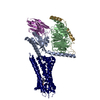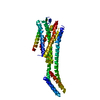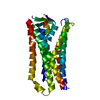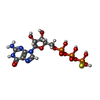+ Open data
Open data
- Basic information
Basic information
| Entry | Database: PDB / ID: 8htg | ||||||
|---|---|---|---|---|---|---|---|
| Title | Crystal structure of Golf in complex with GTP-gamma S and Mg | ||||||
 Components Components | Guanine nucleotide-binding protein G(olf) subunit alpha | ||||||
 Keywords Keywords |  SIGNALING PROTEIN / SIGNALING PROTEIN /  G protein G protein | ||||||
| Function / homology |  Function and homology information Function and homology informationAdenylate cyclase activating pathway / Adenylate cyclase inhibitory pathway / Olfactory Signaling Pathway / cellular response to dopamine / response to caffeine / regulation of long-term synaptic depression / response to amphetamine / G protein-coupled receptor binding / G-protein beta/gamma-subunit complex binding / adenylate cyclase-modulating G protein-coupled receptor signaling pathway ...Adenylate cyclase activating pathway / Adenylate cyclase inhibitory pathway / Olfactory Signaling Pathway / cellular response to dopamine / response to caffeine / regulation of long-term synaptic depression / response to amphetamine / G protein-coupled receptor binding / G-protein beta/gamma-subunit complex binding / adenylate cyclase-modulating G protein-coupled receptor signaling pathway / adenylate cyclase-activating G protein-coupled receptor signaling pathway / adenylate cyclase-activating dopamine receptor signaling pathway /  heterotrimeric G-protein complex / sensory perception of smell / G protein-coupled receptor signaling pathway / heterotrimeric G-protein complex / sensory perception of smell / G protein-coupled receptor signaling pathway /  GTPase activity / GTP binding / GTPase activity / GTP binding /  metal ion binding / metal ion binding /  plasma membrane plasma membraneSimilarity search - Function | ||||||
| Biological species |   Mus musculus (house mouse) Mus musculus (house mouse) | ||||||
| Method |  X-RAY DIFFRACTION / X-RAY DIFFRACTION /  SYNCHROTRON / SYNCHROTRON /  MOLECULAR REPLACEMENT / Resolution: 2.91 Å MOLECULAR REPLACEMENT / Resolution: 2.91 Å | ||||||
 Authors Authors | Kang, H. / Choi, H.-J. | ||||||
| Funding support |  Korea, Republic Of, 1items Korea, Republic Of, 1items
| ||||||
 Citation Citation |  Journal: Nat Commun / Year: 2023 Journal: Nat Commun / Year: 2023Title: Understanding the molecular mechanisms of odorant binding and activation of the human OR52 family. Authors: Chulwon Choi / Jungnam Bae / Seonghan Kim / Seho Lee / Hyunook Kang / Jinuk Kim / Injin Bang / Kiheon Kim / Won-Ki Huh / Chaok Seok / Hahnbeom Park / Wonpil Im / Hee-Jung Choi /   Abstract: Structural and mechanistic studies on human odorant receptors (ORs), key in olfactory signaling, are challenging because of their low surface expression in heterologous cells. The recent structure of ...Structural and mechanistic studies on human odorant receptors (ORs), key in olfactory signaling, are challenging because of their low surface expression in heterologous cells. The recent structure of OR51E2 bound to propionate provided molecular insight into odorant recognition, but the lack of an inactive OR structure limited understanding of the activation mechanism of ORs upon odorant binding. Here, we determined the cryo-electron microscopy structures of consensus OR52 (OR52), a representative of the OR52 family, in the ligand-free (apo) and octanoate-bound states. The apo structure of OR52 reveals a large opening between transmembrane helices (TMs) 5 and 6. A comparison between the apo and active structures of OR52 demonstrates the inward and outward movements of the extracellular and intracellular segments of TM6, respectively. These results, combined with molecular dynamics simulations and signaling assays, shed light on the molecular mechanisms of odorant binding and activation of the OR52 family. | ||||||
| History |
|
- Structure visualization
Structure visualization
| Structure viewer | Molecule:  Molmil Molmil Jmol/JSmol Jmol/JSmol |
|---|
- Downloads & links
Downloads & links
- Download
Download
| PDBx/mmCIF format |  8htg.cif.gz 8htg.cif.gz | 285 KB | Display |  PDBx/mmCIF format PDBx/mmCIF format |
|---|---|---|---|---|
| PDB format |  pdb8htg.ent.gz pdb8htg.ent.gz | 227.3 KB | Display |  PDB format PDB format |
| PDBx/mmJSON format |  8htg.json.gz 8htg.json.gz | Tree view |  PDBx/mmJSON format PDBx/mmJSON format | |
| Others |  Other downloads Other downloads |
-Validation report
| Arichive directory |  https://data.pdbj.org/pub/pdb/validation_reports/ht/8htg https://data.pdbj.org/pub/pdb/validation_reports/ht/8htg ftp://data.pdbj.org/pub/pdb/validation_reports/ht/8htg ftp://data.pdbj.org/pub/pdb/validation_reports/ht/8htg | HTTPS FTP |
|---|
-Related structure data
| Related structure data |  8htiC  8j46C  8w77C C: citing same article ( |
|---|---|
| Similar structure data | Similarity search - Function & homology  F&H Search F&H Search |
- Links
Links
- Assembly
Assembly
| Deposited unit | 
| ||||||||
|---|---|---|---|---|---|---|---|---|---|
| 1 |
| ||||||||
| 2 |
| ||||||||
| 3 |
| ||||||||
| 4 |
| ||||||||
| Unit cell |
|
- Components
Components
-Protein , 1 types, 4 molecules ABCD
| #1: Protein | Mass: 46067.273 Da / Num. of mol.: 4 / Mutation: C3S Source method: isolated from a genetically manipulated source Source: (gene. exp.)   Mus musculus (house mouse) / Gene: Gnal / Production host: Mus musculus (house mouse) / Gene: Gnal / Production host:   Spodoptera frugiperda (fall armyworm) / References: UniProt: Q8CGK7 Spodoptera frugiperda (fall armyworm) / References: UniProt: Q8CGK7 |
|---|
-Non-polymers , 5 types, 65 molecules 








| #2: Chemical |  Ethylene glycol Ethylene glycol#3: Chemical | ChemComp-MG / #4: Chemical | ChemComp-GSP / #5: Chemical |  Phosphate Phosphate#6: Water | ChemComp-HOH / |  Water Water |
|---|
-Details
| Has ligand of interest | Y |
|---|
-Experimental details
-Experiment
| Experiment | Method:  X-RAY DIFFRACTION / Number of used crystals: 1 X-RAY DIFFRACTION / Number of used crystals: 1 |
|---|
- Sample preparation
Sample preparation
| Crystal | Density Matthews: 1.91 Å3/Da / Density % sol: 35.5 % |
|---|---|
Crystal grow | Temperature: 295 K / Method: vapor diffusion, hanging drop / Details: 18% PEG 3350, 0.2M MgCl2 |
-Data collection
| Diffraction | Mean temperature: 100 K / Serial crystal experiment: N |
|---|---|
| Diffraction source | Source:  SYNCHROTRON / Site: PAL/PLS SYNCHROTRON / Site: PAL/PLS  / Beamline: 5C (4A) / Wavelength: 0.9794 Å / Beamline: 5C (4A) / Wavelength: 0.9794 Å |
| Detector | Type: DECTRIS EIGER X 9M / Detector: PIXEL / Date: May 21, 2020 |
| Radiation | Protocol: SINGLE WAVELENGTH / Monochromatic (M) / Laue (L): M / Scattering type: x-ray |
| Radiation wavelength | Wavelength : 0.9794 Å / Relative weight: 1 : 0.9794 Å / Relative weight: 1 |
| Reflection | Resolution: 2.91→27.57 Å / Num. obs: 30932 / % possible obs: 99.4 % / Redundancy: 3.4 % / Biso Wilson estimate: 43.54 Å2 / CC1/2: 0.983 / CC star: 0.996 / Rmerge(I) obs: 0.1779 / Rpim(I) all: 0.1122 / Rrim(I) all: 0.2108 / Net I/σ(I): 7.13 |
| Reflection shell | Resolution: 2.91→3.01 Å / Redundancy: 3.5 % / Rmerge(I) obs: 0.8078 / Mean I/σ(I) obs: 1.48 / Num. unique obs: 3030 / CC1/2: 0.67 / CC star: 0.896 / Rpim(I) all: 0.5036 / Rrim(I) all: 0.9542 / % possible all: 99.84 |
- Processing
Processing
| Software |
| ||||||||||||||||||||||||||||||||||||||||||||||||||||||||||||||||||||||||||||||||||||
|---|---|---|---|---|---|---|---|---|---|---|---|---|---|---|---|---|---|---|---|---|---|---|---|---|---|---|---|---|---|---|---|---|---|---|---|---|---|---|---|---|---|---|---|---|---|---|---|---|---|---|---|---|---|---|---|---|---|---|---|---|---|---|---|---|---|---|---|---|---|---|---|---|---|---|---|---|---|---|---|---|---|---|---|---|---|
| Refinement | Method to determine structure : :  MOLECULAR REPLACEMENT / Resolution: 2.91→27.57 Å / SU ML: 0.42 / Cross valid method: FREE R-VALUE / σ(F): 1.36 / Phase error: 28.73 / Stereochemistry target values: ML MOLECULAR REPLACEMENT / Resolution: 2.91→27.57 Å / SU ML: 0.42 / Cross valid method: FREE R-VALUE / σ(F): 1.36 / Phase error: 28.73 / Stereochemistry target values: ML
| ||||||||||||||||||||||||||||||||||||||||||||||||||||||||||||||||||||||||||||||||||||
| Solvent computation | Shrinkage radii: 0.9 Å / VDW probe radii: 1.11 Å / Solvent model: FLAT BULK SOLVENT MODEL | ||||||||||||||||||||||||||||||||||||||||||||||||||||||||||||||||||||||||||||||||||||
| Refinement step | Cycle: LAST / Resolution: 2.91→27.57 Å
| ||||||||||||||||||||||||||||||||||||||||||||||||||||||||||||||||||||||||||||||||||||
| Refine LS restraints |
| ||||||||||||||||||||||||||||||||||||||||||||||||||||||||||||||||||||||||||||||||||||
| LS refinement shell |
|
 Movie
Movie Controller
Controller









 PDBj
PDBj








